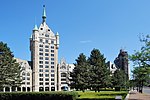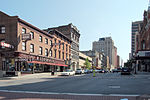Irish American Heritage Museum
Ethnic museums in New York (state)History museums in New York (state)Irish-American culture in New York (state)Irish-American museumsMuseums in Albany, New York
The Irish American Heritage Museum is a museum in Albany, New York. The museum describes their educational mission as "To preserve and tell the story of the contributions of the Irish people and their culture in America, inspiring individuals to examine the importance of their own heritage as part of the American cultural mosaic."
Excerpt from the Wikipedia article Irish American Heritage Museum (License: CC BY-SA 3.0, Authors).Irish American Heritage Museum
Broadway, City of Albany
Geographical coordinates (GPS) Address Nearby Places Show on map
Geographical coordinates (GPS)
| Latitude | Longitude |
|---|---|
| N 42.647163 ° | E -73.750636 ° |
Address
Old Trailways Building
Broadway 358
12204 City of Albany
New York, United States
Open on Google Maps







